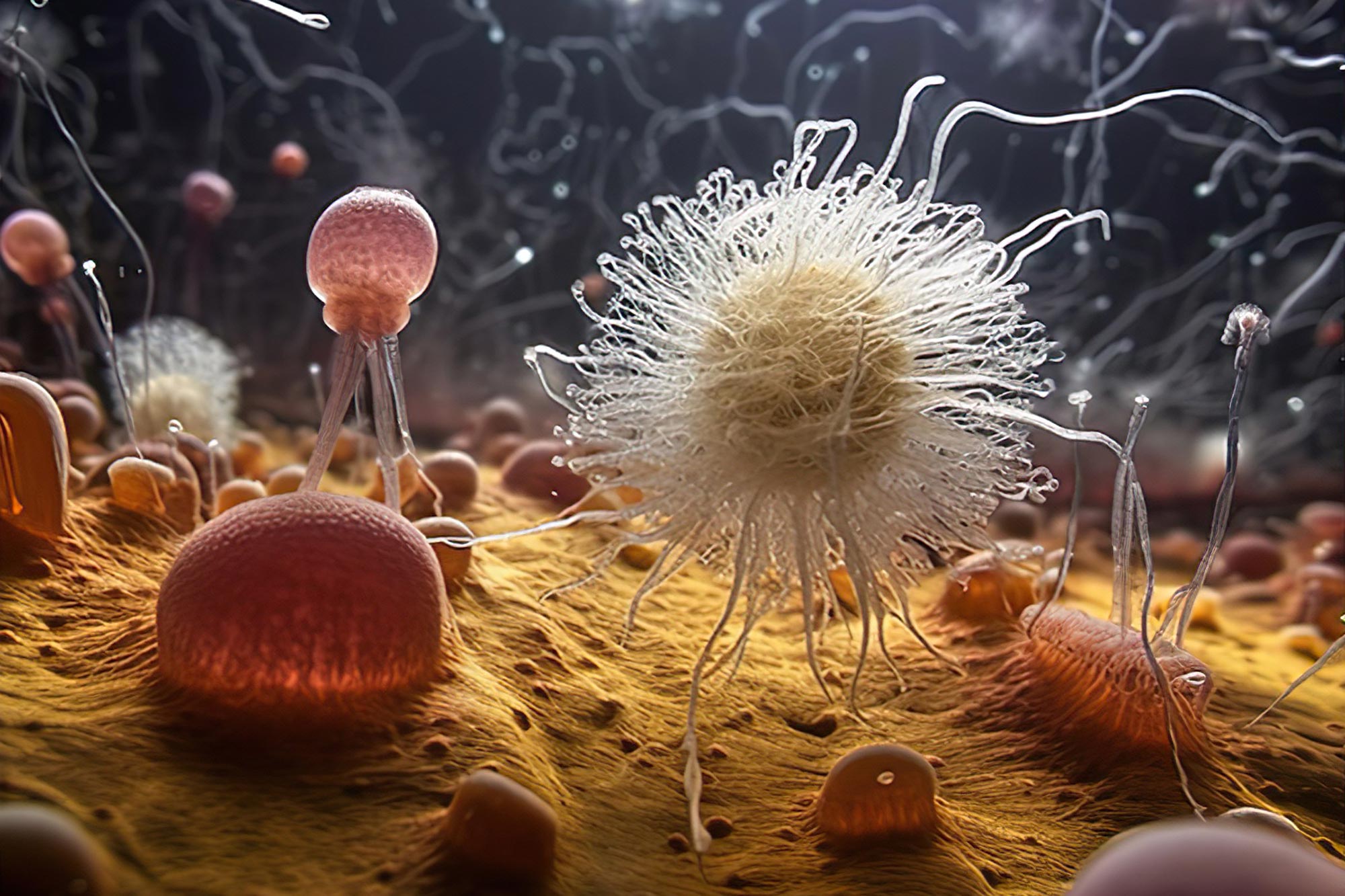بواسطة

انطباع الفنان عن مجموعة من الكائنات حقيقية النواة البدائية تسمى “حيوي البروتوستيرول” تعيش في حصيرة بكتيرية في قاع المحيط. استنادًا إلى الحفريات الجزيئية ، عاشت الكائنات الحية من البروتوستيرول في المحيطات منذ حوالي 1.6 إلى 1.0 مليار سنة وكانت أسلافنا الأوائل. الائتمان: تم تنظيمه في Midjourney بواسطة TA 2023
وجد فريق بحث متعدد الجنسيات بروتسترويدات قديمة في الصخور ، مما يشير إلى وجود حياة معقدة منذ 1.6 مليار سنة. توفر هذه الجزيئات نظرة ثاقبة جديدة لتطور الحياة المعقدة وتسوية التناقضات بين سجلات الأحافير الكلاسيكية والدهنية.
أظهر السجل المكتشف حديثًا لما يسمى بالبروتسترويدات أنها كانت وفيرة بشكل مدهش طوال العصور الوسطى للأرض. تم إنتاج الجزيئات الأولى في مرحلة مبكرة من تعقيد حقيقيات النوى – مما زاد من السجل الحالي للستيرويدات الأحفورية إلى ما بعد 800 وحتى 1600 مليون سنة مضت. حقيقيات النوى مصطلح يشير إلى مملكة حياة منفصلة عن كل الحيوانات والنباتات والطحالب والبكتيريا ، مع بنية خلوية معقدة تشتمل على نواة وآلية جزيئية أكثر تعقيدًا.
يقول أحد المشاركين كريستيان هولمان من مركز الأبحاث الألماني (GFZ) في بوتسدام: “إن أهم ما يميز هذا الاكتشاف ليس فقط توسيع السجل الجزيئي الحالي لحقيقيات النوى”. “نظرًا لأن السلف المشترك الأخير لجميع حقيقيات النوى الحديثة ، بما في ذلك نحن البشر ، كان قادرًا على إنتاج ستيرولات حديثة” نموذجية “، فمن المحتمل جدًا أن حقيقيات النوى المسؤولة عن هذه التوقيعات النادرة تنتمي إلى جذع شجرة النشوء والتطور.”

يقوم Benjamin Nettersheim ، أحد المؤلفين الرئيسيين للدراسة ، بفحص الخرائط الأولية والجزيئية فائقة الدقة لعينات صخرية عمرها 1.64 مليار عام تم تحليلها في مختبر التصوير الجيولوجي الجزيئي في MARUM. الائتمان: MARUM – مركز علوم البيئة البحرية ، جامعة بريمن ؛ الخامس. ديكامب
يمثل هذا “الجذع” سلالة الأسلاف المشتركة التي أدت إلى ظهور جميع الفروع التي لا تزال حية من حقيقيات النوى. ممثلوها منقرضون منذ فترة طويلة ، لكن تفاصيل طبيعتهم قد تلقي مزيدًا من الضوء على الظروف المحيطة بتطور الحياة المعقدة. على الرغم من الحاجة إلى مزيد من البحث لتقدير النسبة المئوية للبروتسترويدات التي لها أصل بكتيري نادر ، فإن اكتشاف هذه الجزيئات الجديدة لا يوفق فقط بين السجل الجيولوجي للحفريات التقليدية وجزيئات الدهون الأحفورية ، ولكنه يوفر أيضًا وجهة نظر نادرة وغير مسبوقة. عالم ضائع من الحياة القديمة. يمثل الانقراض التنافسي لحقيقيات النوى للمجموعة الجذعية ، الذي تميز بالظهور الأول للستيرويدات الأحفورية الحديثة منذ 800 مليون سنة ، أحد أكثر الأحداث خطورة في تطور الحياة المعقدة بشكل متزايد.
“مثل الكوليسترول الذي ينتجه البشر والحيوانات الأخرى ، فإن جميع حقيقيات النوى تنتج المنشطات النشطة بيولوجيًا” ، كما يقول بنجامين نيتيرسهايم من MARUM في جامعة بريمن.[{” attribute=””>Australian National University (ANU) – “due to potentially adverse health effects of elevated cholesterol levels in humans, cholesterol doesn’t have the best reputation from a medical perspective. However, these lipid molecules are integral parts of eukaryotic cell membranes where they aid in a variety of physiological functions. By searching for fossilized steroids in ancient rocks, we can trace the evolution of increasingly complex life.”

Dr. Nettersheim inserts a thin section and rock slices of 1.64 billion-years old rocks into the 7T solariX XR FT-ICR-MS equipped with a MALDI source at the Geobiomolecular Imaging Laboratory at MARUM. As part of ongoing research into mid-Proterozoic biomarker signatures at MARUM, GFZ and the Australian National University, Dr. Nettersheim aims to zoom into the cradle of eukaryotic life in unprecedented resolution. Credit: MARUM – Center for Marine Environmental Sciences, University of Bremen; V. Diekamp
Nobel laureate Konrad Bloch had already speculated about such a biomarker in an essay almost 30 years ago. Bloch suggested that short-lived intermediates in the modern biosynthesis of steroids may not always have been intermediates. He believed that lipid biosynthesis evolved in parallel with changing environmental conditions throughout Earth history. In contrast to Bloch, who did not believe that these ancient intermediates could ever be found, Nettersheim started searching for protosteroids in ancient rocks that were deposited at a time when those intermediates could actually have been the final product.
But how to find such molecules in ancient rocks? “We employed a combination of techniques to first convert various modern steroids to their fossilized equivalent; otherwise, we wouldn’t have even known what to look for,” says Jochen Brocks. Scientists had overlooked these molecules for decades because they do not conform to typical molecular search images. “Once we knew our target, we discovered that dozens of other rocks, taken from billion-year-old waterways across the world, were oozing with similar fossil molecules.”
The oldest samples with the biomarker are from the Barney Creek Formation in Australia and are 1.64 billion years old. The rock record of the next 800 million years only yields fossil molecules of primordial eukaryotes before molecular signatures of modern eukaryotes first appear in the Tonian period. According to Nettersheim “the Tonian Transformation emerges as one of the most profound ecological turning points in our planet´s history“. Hallmann adds that “both primordial stem groups and modern eukaryotic representatives such as red algae may have lived side by side for many hundreds of millions of years”. During this time, however, the Earth’s atmosphere became increasingly enriched with oxygen – a metabolic product of cyanobacteria and of the first eukaryotic algae – that would have been toxic to many other organisms. Later, global “Snowball Earth” glaciations occurred and the protosterol communities largely died out. The last common ancestor of all living eukaryotes may have lived 1.2 to 1.8 billion years ago. Its descendants were likely better able to survive heat and cold as well as UV radiation and displaced their primordial relatives.
“Earth was a microbial world for much of its history and left few traces,” Nettersheim concludes. Research at ANU, MARUM and GFZ continues to pursue tracing the roots of our existence – the discovery of protosterols now brings us one step closer to understanding how our earliest ancestors lived and evolved. Shooting at the ancient rocks with a laser coupled to an ultra-high resolution mass spectrometer in MARUM’s globally unique Geobiomolecular Imaging Laboratory, Dr. Nettersheim and his international collaborators aim at zooming into the cradle of eukaryotic life in unprecedented resolution to further improve our understanding of our early ancestors in the future.
Reference: “Lost world of complex life and the late rise of the eukaryotic crown” by Jochen J. Brocks, Benjamin J. Nettersheim, Pierre Adam, Philippe Schaeffer, Amber J. M. Jarrett, Nur Güneli, Tharika Liyanage, Lennart M. van Maldegem, Christian Hallmann and Janet M. Hope, 7 June 2023, Nature.
DOI: 10.1038/s41586-023-06170-w
Participating Institutions:
- Research School of Earth Sciences, The Australian National University, Canberra, Australia
- MARUM – Center for Marine Environmental Sciences, University of Bremen, Bremen, Germany
- Faculty of Geosciences, University of Bremen, Bremen, Germany
- Université de Strasbourg, CNRS, Institut de Chimie de Strasbourg, Strasbourg, France
- Northern Territory Geological Survey, Darwin, Australia
- German Research Center for Geosciences (GFZ), Potsdam, Germany
MARUM produces fundamental scientific knowledge about the role of the ocean and the ocean floor in the total Earth system. The dynamics of the ocean and the ocean floor significantly impact the entire Earth system through the interaction of geological, physical, biological and chemical processes. These influence both the climate and the global carbon cycle, and create unique biological systems. MARUM is committed to fundamental and unbiased research in the interests of society and the marine environment, and in accordance with the Sustainable Development Goals of the United Nations. It publishes its quality-assured scientific data and makes it publicly available. MARUM informs the public about new discoveries in the marine environment and provides practical knowledge through its dialogue with society. MARUM cooperates with commercial and industrial partners in accordance with its goal of protecting the marine environment.

“متعصب التلفزيون. مدمن الويب. مبشر السفر. رجل أعمال متمني. مستكشف هواة. كاتب.”







More Stories
خريطة جديدة للمريخ تكشف عن “هياكل” مخفية تحت سطح المريخ
زوج من نفاثات البلازما الضخمة تندلع من ثقب أسود هائل | الثقوب السوداء
الأسمنت المستوحى من عظام الإنسان أصعب بخمس مرات من الخرسانة العادية